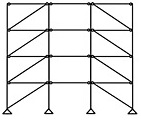Lateral loads
Lateral loads are live loads that are applied parallel to the ground; that is, they are horizontal forces acting on a structure. They are different to gravity loads for example which are vertical, downward forces.
The most common types are:
Wind load may not be a significant concern for small, massive, low-level buildings, but becomes more importance with height, the use of lighter materials and the use of shapes that may affect the flow of air, typically roof forms.
Significant seismic loads can be imposed on a structure during an earthquake. They are likely to be relatively instantaneous loads compared to wind loads. Buildings in areas of seismic activity need to be carefully designed to ensure they do not fail if an earthquake should occur.
Water pressure tends to exert a lateral load which increases linearly with depth and is proportional to the liquid density. Similarly, earth pressure (such as settlement) can be applied against below-ground structures such as basement walls, retaining walls, and so on.
Lateral loads such as wind load, water and earth pressure have the potential to become an uplift force (an upward pressure applied to a structure that has the potential to raise it relative to its surroundings). For more information, see Uplift force.
Structures should be designed carefully with likely lateral loads in mind. A structural element that is typically used to resist lateral loads is a shear wall. In simple terms, lateral forces could push over parallel structural panels of a building were it not for perpendicular shear walls keeping them upright. For more information see: Shear wall.
Similarly, bracing can be used to resist lateral loads. The beams and columns of a braced frame structure carry vertical loads, whilst the bracing carries the lateral loads. For more information, see Braced frame structure.
[edit] Related articles on Designing Buildings Wiki
- Bearing capacity.
- Bending moment.
- Biaxial bending.
- Braced frame.
- Dead loads.
- Floor loading.
- Force.
- Ground heave.
- Hurricane design considerations.
- Limit state design.
- Live loads.
- Loadbearing capacity.
- Moment.
- Point of contraflexure.
- Settlement of buildings.
- Shear force.
- Shear wall.
- Structural engineer.
- The design of temporary structures and wind adjacent to tall buildings.
- Torsion.
- Types of structural load.
- Uniformly Distributed Load.
- Uplift force.
- Vibrations.
- Wind load.
Featured articles and news
Infrastructure that connect the physical and digital domains.
Harnessing robotics and AI in challenging environments
The key to nuclear decommissioning and fusion engineering.
BSRIA announces Lisa Ashworth as new CEO
Tasked with furthering BSRIA’s impressive growth ambitions.
Public buildings get half a million energy efficiency boost
£557 million to switch to cleaner heating and save on energy.
CIOB launches pre-election manifesto
Outlining potential future policies for the next government.
Grenfell Tower Inquiry announcement
Phase 2 hearings come to a close and the final report due in September.
Progress from Parts L, F and O: A whitepaper, one year on.
A replicated study to understand the opinion of practitioners.
ECA announces new president 2024
Electrical engineer and business leader Stuart Smith.
A distinct type of countryside that should be celebrated.
Should Part O be extended to existing buildings?
EAC brands heatwave adaptation a missed opportunity.
Definition of Statutory in workplace and facilities management
Established by IWFM, BESA, CIBSE and BSRIA.
Tackling the transition from traditional heating systems
59% lack the necessary information and confidence to switch.
The general election and the construction industry
As PM, Rishi Sunak announces July 4 date for an election.
Eco apprenticeships continue help grow green workforce
A year after being recognised at the King's coronation.
Permitted development rights for agricultural buildings
The changes coming into effect as of May 21, 2024.























